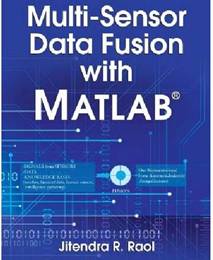

|
BOOKSBOOKSBOOKS
Multi-Sensor Data Fusion with MATLAB
by Jitendra R. Raol CRC Press, 2009
Reviewed by Zheng Liu (Canada) |
|
This book is one of the most recent monographs on data fusion. It has comprehensive coverage of data fusion techniques. But, what makes it remarkable is the MATLAB code that comes with the book, so I expect to see how the fusion algorithms are implemented and practiced for those examples. The book consists of five parts: 1) theory of data fusion and kinematic-level fusion; 2) fuzzy logic and decision fusion; 3) pixel- and feature-level image fusion, 4) a brief on data fusion in other systems, and 5) appendix. The first four parts focus on relatively independent aspects of data fusion technique and applications while the appendix provides the basic mathematical fundamentals and information required by the other parts. Each part has an introductory chapter. Part I has five chapters in total. As data fusion deals with kinematic states and dynamic states, the term "kinematic-level fusion" is used as the title of Part I. The concepts and theory of data fusion are presented in Chapter 2, which discusses the process, architectures, models, and methodologies for data fusion. A big picture of data fusion is explicitly depicted in this chapter. Chapters Three and Four mainly focus on the fusion aspects for target tracking. Part II presents the topic of fuzzy logic and its application to decision fusion. Starting with the introductory chapter (Chapter 5), the rest of Part II is composed of three chapters: theory of fuzzy logic, decision fusion, and performance evaluation of fuzzy logic based decision systems. A tutorial on the theory of fuzzy logic is presented first. The use of fuzzy logic to estimate the unknown states of a dynamic system is described in Chapter 7. The approaches for performance evaluation are highlighted in Chapter 8. Chapters 9 to 11constitute Part III, i.e. pixel- and feature-level image fusion. Again, the introduction gives the basic information. Two subsections of Chapter 10, "10.2.2 metrics for performance evaluation" and "10.3.3 performance evaluation", seem to be more suitable for next chapter (Chapter 11), which is titled as "performance evaluation of image-based data fusion systems". And the section "10.5 feature-level fusion methods" can be better organized as well. This is my personal point of view. Chapter 11, as implied by its title, is supposed to describe the performance metrics for image fusion, but it describes the registration and fusion for target tracking applications. As far as the content is concerned, this part does provide the essential information on image fusion. Part IV presents a brief on data fusion for mobile intelligent autonomous systems and intelligent monitoring systems. Unlike other books with similar titles, MATLAB exercises are not provided for each chapter. Instead, the illustrative examples are available only as independent subsections in Chapters 3, 8, and 10, while not in some others, for instance Example 11.2. MATLAB solutions can be downloaded from the book's website as a compressed file. Although only a limited number of MATLAB examples/exercises are available in this edition of the book, I still value the importance these exercises for understanding what is behind those equations. Overall, this book is featured with the integrity of relevant information and can serve as a good reference for graduate students and researchers in the field of data fusion. Readers will benefit from the MATLAB examples, especially if more exercises are available in future editions. |
|
Click on the image (above) to go to the publisher’s web page for this book where you will find a description of the book, the Table of Contents, a link to Downloads & Updates, and an Author Biography |
